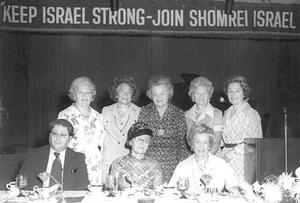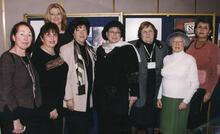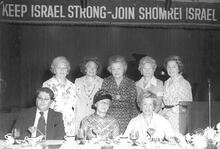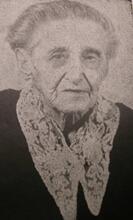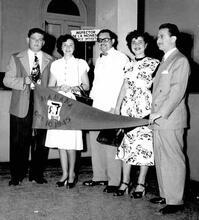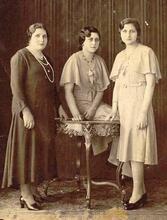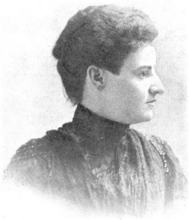Religious Zionist Movements in Palestine
The Women’s Mizrachi Federation in America, founded in 1925, was led in cities throughout the United States by women who were highly-educated, passionately religious Zionists, active both in their home communities and on behalf of Israel. This Women's Mizrachi event in 1960s Detroit, Michigan, was organized by Yetta Sperka, a playwright, speaker, and activist in women's, Jewish and Zionist causes.
Institution: Deanna Mirsky Sperka, Detroit
Women established their own organizations within Mizrachi (religious Zionist) movements of the early twentieth century to address their particular needs and audience. In pre-state Palestine, the Mizrachi Women’s Federation was founded in 1918 and the Women’s Branch of the Ha-Po’el ha-Mizrachi was founded in 1935. While the latter had a particular focus on women workers as an organization of the Mizrachi trade union wing, both were concerned with attracting women to the religious Zionist movement and its goals of establishing a religious Jewish state. They provided education, career training, and cultural events to women of the Yishuv. Though they viewed each other as competitors for many years, they merged in 1959 in the Women’s National Religious Movement, which was renamed Emunah in 1977.
Within the Jewish community in Palestine prior to the establishment of the State of Israel. "Old Yishuv" refers to the Jewish community prior to 1882; "New Yishuv" to that following 1882.Yishuv society of pre-state Israel, there developed a unique sector with a complex ideology: a religious Zionist society that included two main movements, the Mizrachi (founded 1902) and the Ha-Po’el ha-Mizrachi (1922). Religious Zionism—whose Hebrew name, Mizrachi, is an acronym for merkhaz ruhani, which translates literally to “religious center,” should not be confused with the ethnic group Lit. "Eastern." Jew from Arab or Muslim country.Mizrahi—sought to preserve tradition while also adopting modern ideas. It was distinguished from the secular majority by its religious nature and from the ultra-Orthodox minority by its Zionism.
During the Mandate period, the Yishuv concentrated on building a national homeland, fostering essential institutions and enterprises to this end. Many voluntary organizations operated in the Yishuv in various fields, among them women’s organizations established during World War I and immediately afterwards, at a time when Jewish women’s organizations were blossoming worldwide. Two such organizations were set up in the framework of religious Zionism in The Land of IsraelErez Israel: The Mizrachi Women’s Federation, founded in 1918, and the Women’s Branch of the Ha-Po’el ha-Mizrachi, founded in 1935. These organizations, like others of their kind, were profoundly affected by the social and economic factors that typified the period: increased immigration, an unstable economic situation and recession, World War II, and the Holocaust.
Beginning in 1915, Mizrachi women’s organizations were founded throughout the Jewish world. The groups had two parallel paths of action. One was activism among women in their own countries, while the other was helping to build Erez Israel in the spirit of religious Zionism. As part of the latter effort, they cooperated with religious women in Erez Israel and gave them material help.
Mizrachi Women in the United States: From Assistants to Leaders
Since these scattered groups worked as auxiliaries for the Mizrachi Organization that was founded at the same time, their work was partial and restricted in its scope. In 1925, the Women’s Mizrachi Federation in America was founded, led by Adela Goldstein (d. 1938), a businesswoman with religious Zionist beliefs who traveled to various cities in the United States and unified the women’s groups into a national federation with common goals. Under her leadership, the women in America began to act independently, no longer as Mizrachi branch auxiliaries. At the same time, a Mizrachi youth organization was also founded for young women.
The fundamental goal of the Women’s Mizrachi Federation in America was to help build a national homeland in the spirit of Torah she-bi-khetav: Lit. "the written Torah." The Bible; the Pentateuch; Tanakh (the Pentateuch, Prophets and Hagiographia)Torah according to Mizrachi ideology. In order to promote this goal, the women worked as an integral part of Mizrachi and cooperated with various Zionist organizations. The decision to work on behalf of women was made from the first, when a desire to aid pioneer women in Erez Israel combined with Lit. (Greek) "dispersion." The Jewish community, and its areas of residence, outside Erez Israel.Diaspora women’s aspirations to help build the country. After learning and understanding the conditions in the country, the women decided to concentrate their efforts on realizing one goal: professional education for young religious girls in Erez Israel. The two goals—helping to build a religious Erez Israel and educating young girls—combined in the form of educational work that would be undertaken in the spirit of the Mizrachi movement: including tradition and Torah in the values of national rebirth.
During the 1920s and 1930s, the federation took new directions. New branches opened and the number of members increased. In 1939, there were 73 branches of the Women’s Mizrachi Federation with 15,000 members. In 1942 the federation had 35,000 members and in 1948 the number increased to about 40,000. During the 1940s the Women’s Mizrachi Federation was described as one of the most active women’s Zionist federations in the United States.
The leaders of the Women’s Mizrachi Federation in America tended to be religious and enthusiastically Zionist, activist, and educated. All of them shared the aspiration to work for the settlement of Erez Israel. Outstanding among them were Adela Goldstein, who was the organization’s energetic driving force; Bessie Gotsfeld, who was a member of the federation’s board of directors and its representative in Erez Israel; Irena Shapira, the second president of Mizrachi Women in America from 1934 to 1942; and Bluma Yehudit Goldstein, who was the federation’s president from 1942 and typified the women who were both traditional and a product of American culture, well-versed in Zionism and Mizrachi’s role in building the land. These women led the organization to noteworthy achievements.
The work of the Women’s Mizrachi Federation in Erez Israel combined independent action on the one hand and financial support of the settlement enterprise on the other. Cooperation between religious Zionist women in Erez Israel and Mizrachi women in America enabled the development of national groups and contributed much to their activity. Mizrachi Women in America set up enterprises that were managed by the religious women’s organizations in Erez Israel and financed a great part of women’s activity in the country.
While Mizrachi Women in America responded to the needs of the settlement enterprise, they also acted independently as its members saw fit, sometimes with the agreement of the movement in Erez Israel and occasionally to its displeasure. Alongside the cooperation, there were occasional disagreements between the Mizrachi women of America and the groups in Erez Israel, particularly Ha-Po’el Ha-Mizrachi. These disagreements focused on the differences between the goals of the philanthropic women’s organization and those of the pioneering-proletariat organization. There were also conflicts between these groups regarding finances. The American Mizrachi women, who acted according to the old rule of “He who pays the piper calls the tune,” did not give in to the movement in Erez Israel. They worked according to their aspirations and in their many meetings their independence and refusal to submit to the men’s organizations stood out, along with their readiness to work to the satisfaction of the groups in Erez Israel.
Women’s Mizrachi Federation in Erez Israel
Hinda Ostrovsky laid the foundation for the Mizrachi women’s organization in Erez Israel in the Lit. "village." The dominant pioneer settlement type of the Jews in Palestine between 1882moshavah of Ekron at the end of World War I. The first women’s group of Mizrachi Women in Erez Israel declared its solidarity with the men’s organization, saying: “We, the women of the moshavah, are entering the Zionist Mizrachi organization and will work together with the men to build the nation according to Torah and religious faith.” The women’s goal was to work together with the men to realize the “Mizrachi idea” and to win women adherents for the movement. The Mizrachi movement was pleased with this direction and hoped that a network of religious-Zionist women’s groups would spread throughout the country.
1919–1938: Local Organization
The Women’s Mizrachi Federation in Jerusalem was founded in Elul 5679 (September 1919) as a branch that worked locally, led by Leah Seliger. Hinda Ostrovsky, who moved to Jerusalem about a year after the women’s group in Ekron was founded, joined the federation, membership in which was open to all women aged seventeen and above. In 1922 it had more than 600 members.
As the federation in Jerusalem developed, other branches opened throughout the country. These were run democratically and had constant contact with the women’s group in Jerusalem, which was dominant among them during the 1920s. In 1929, the Women’s Mizrachi Federation of Tel Aviv was founded, led by Leah Kook. This federation developed independently and by 1940 had hundreds of members.
The goal of the Women’s Mizrachi Federation at its founding was to act together with the men for Mizrachi goals—that is, to work among women and draw them into the Mizrachi movement to realize the idea of national revival in Erez Israel in the spirit of the Torah. According to the women’s declaration: “Our federation’s aspiration is the same as that of world Mizrachi: to establish our existence in our country on the foundations of our written Torah and our tradition. … Our goal is to sustain Israel’s holiness and encourage the spirit of Judaism among our nation’s mothers and daughters. Our duty is to awaken in their hearts love of the people, the Torah and the country, so that they too will aid in the realization of the Mizrachi goal: the rebirth of the nation of Israel in the land of Israel according to the Torah of Israel.”
Until the 1930s the Women’s Mizrachi Federations were local organizations with no connection between them, but with great affinity for the Mizrachi movement, whose goals they adopted and supported. Each local group developed differently, according to the conditions of the area in which it operated, beginning cooperative work only after the national organization was founded.
1940: National Organization
The need for a national center that would direct the activities of the women’s federations led to the establishment of the National Organization of Mizrachi Women. A temporary committee headed by Dr. Esther Rabin of the Haifa branch was elected in December 1937, as a first step in setting up the organization. Meeting in February 1938, the committee defined the central women’s organization’s goals: education of women in the Mizrachi spirit; participation in Mizrachi movement social work (mainly aid to women); political action; and contact with Mizrachi women all over the world. The major goal remained: to promote the Mizrachi idea among women along with traditional female activities such as social work, but also community work and development of a more general vision of the women’s organization.
Sarah Herzog (1899–1979), the wife of Chief Rabbi Isaac Herzog (1889–1959), who came to Palestine in 1936, was active in developing the national organization. The difficult security and economic situation in the Yishuv, combined with the increasing stream of immigrants, necessitated development and increased activity. New forces congregated around Sarah Herzog, a work program was drawn up, bylaws written, and a working committee elected.
Omen, the Mizrachi women’s organization in Erez Israel, was officially established in 1940 with Sarah Herzog as its leader. It included all the groups and institutions of “Mizrachi-type” religious women in the country. Bessie Gotsfeld represented Mizrachi Women in America, though that organization united with Israel’s only after the state was founded. Along with Omen, the branch organizations continued to operate as usual. At annual conventions, Mizrachi women from all over the country made decisions for the future.
Omen’s goals were unifying the Women’s Mizrachi Federations in Erez Israel, maintaining contact with Mizrachi women abroad, and encouraging connections with Mizrachi institutions and aiding those who ran them. The female nature of the organization was paramount. The main goal remained organizing women to realize Mizrachi goals. After the Holocaust, there were additional goals which resulted from the condition of the Yishuv and the need to absorb survivors, whose physical and spiritual rehabilitation became an important area of work for the religious women.
The establishment of Omen brought about an upswing in the organization’s development and a significant increase in membership. By August 1948 Omen numbered 15,000 women. The organization’s development enabled it to broaden its activity and to feel that it could have an influence on the running of the Yishuv.
The Women’s Branch of Ha-Po’el Ha-Mizrachi
From 1921: Immigration of Religious Pioneer Women
While the Mizrachi women were busy with local activity, newly-arrived religious pioneer women wanted to take a greater part in building the country. Their acclimation was difficult because there was no appropriate setting to ease their way. The general population of women workers, who were not religious, did not understand the religious pioneer women’s outlook or their desire to continue in a traditional lifestyle that restricted women. The male religious workers, who were modern in their thoughts and actions but still anchored by tradition in everything pertaining to women, found it difficult to accept the religious women pioneers into their ranks. These women therefore faced a double disability, rejected by religious society because of their sex and by general society because of their religious beliefs.
Rahel Berckman-Labkovsky, the first religious woman pioneer, came to Erez Israel in 1921, insisted on joining the men’s Mizrachi trade union, Ha-Po’el ha-Mizrachi, and opened the way for other religious women pioneers. Yet the inclusion of women in the movement was not an adequate response to their economic and social distress. The increased physical suffering of religious women on the one hand and the discrimination they faced in religious and economic society led them to organize in 1934.
1935: Establishment of the National Organization of Religious Pioneer Women
The organization of religious pioneer women was established by new immigrants with experience in movements. Its leader was Tova Sanhadray-Goldreich, who came to Palestine in 1934 and, together with some friends, concluded that they must organize in order to maintain their autonomy while also contributing to building the land. The arrival of more pioneers in Erez Israel, such as Miriam Eliash (1909–1987), Devorah Eliner (1904–1982), Leah Tirosh (1908–1995), Leah Adini (b. 1911), and others, provided a significant impetus to the organization of religious women pioneers. In January 1935 the founding assembly of the Women’s Branch of Ha-Po’el ha-Mizrachi was held. It determined a mechanism for organizing a national council, secretariat, and branches throughout the country, whose representatives would meet at general assemblies.
The major goal of the pioneer women’s organization was to improve the material status and spiritual welfare of the religious women workers and enable them to join Ha-Po’el ha-Mizrachi. Apart from caring for the needs of women workers, the organization insisted on full partnership in the movement and its enterprises. And together with the intention of the women workers to fill “traditional feminine” roles, the organization also called for women’s active participation in national tasks.
The pioneer women’s organization had modest beginnings, without means or experience in organizational work. Though it suffered from the usual difficulties of a nascent organization—indecision as to its direction, lack of members with initiative, lack of experience, budgetary problems and more—its members did not desist from their efforts.
When the organization was set up in 1935, it had about 800 members. By 1948 it had 6,000, a little more than a third of the number of women who had joined Mizrachi that same year. While the Mizrachi women’s organization appealed to the general religious public because of its traditional beliefs, the women workers’ organization was sector-based and had new, socialist ideas. As a result, it attracted members who agreed with its world view and whose aspirations related to the status of workers and pioneer activity.
The main goal of both religious women’s organizations was building the country in a religious spirit. Yet the women workers of the Women’s Branch of Ha-Po’el Ha-Mizrachi advocated distinctly feminist goals as a way to achieve the main objective of attaining the goals of the pioneer movement, while the women of Omen (the Mizrachi women’s organization) refrained from such a declaration. The actual operations of the two movements eventually blurred the difference between them, since the pioneer women’s organization worked according to traditional female roles, while in their actions the Omen women expressed the modernity they did not wish to declare openly.
The Characteristics of the Leaders and Members
The leaders of both movements were outstanding figures in the religious society to which they belonged, even if only by virtue of their initiative. They set up organizations and worked tirelessly in the public sphere which had previously been a male preserve. By their actions, they proved that it was possible to engage in extensive public activity and still maintain a religious lifestyle.
Leaders of the Mizrachi Women’s Organization (Omen)
Leah Seliger, Hinda Ostrovsky, and Sophia-Tikvah Pick were key figures in the Jerusalem group’s establishment and activity. Leah Kook led Omen’s Tel Aviv branch, while Sarah Herzog was a national leader along with Dr. Esther Rabin, Anita Miller-Cohen (1890–?), and Hannah Lenzkron-Farbstein.
While each of the outstanding women had a unique personality, they shared some common characteristics. The leaders of Omen were married and usually mothers. They entered the public sphere because of their husbands or fathers, who were often active in the Mizrachi movement. They had general and Jewish education and in many cases engaged in literary or educational work. They proved that they could be educated and even opinionated, yet still remain faithful to their religion. Once it was clear that education resulted in power and the ability to improve and promote women’s status, they used all their skills to influence religious women. Some of the leaders sometimes received a salary from the movement, but most of them belonged to the middle-class bourgeoisie, financially established and free of the need to work to support themselves. A few of them had a tradition of volunteer work. The organizational experience they acquired created an organizational awareness and helped them establish the Women’s Mizrachi Federation and create the national organization.
Like their leaders, the group’s members were also well-to-do, older Ashkenazi married home-makers willing to contribute their time and money to the organization’s activities. The members paid monthly dues to the federation, but were not among its leaders.
Leaders of the Women’s Branch of Ha-Po’el Ha-Mizrachi
Unlike them, the women members of Ha-Po’el ha-Mizrachi and its leaders were mostly young women who had been active in movements abroad, arrived in Palestine as single women and joined Ha-Po’el ha-Mizrachi. They worked in order to support themselves. Most of them were married to members of the organization but acted independently. Over the years, differences between the women of both organizations decreased and their work ultimately had similar goals.
Women’s Relationship to the Mizrachi Movement
Organizational and Economic Cooperation
The Mizrachi movement supported its women in organizational and financial ways for pragmatic reasons, because the movement needed women for its electorate and in order to promulgate and achieve its goals. But while the women wanted support, they opposed male patronage. As members of the movement they demonstrated independence, refusing to submit to male rule. Unlike the Mizrachi movement, which was concerned only with its own good, the women were concerned with the welfare of all their sex and acted accordingly.
During the 1930s and 1940s the women’s financial dependence on the movement decreased and their activity led to a strengthening of women and to organizational independence as well as representation in movement institutions. This combination of financial dependence with expressions of independence characterized the Mizrachi women’s organization in Erez Israel.
The Women Workers’ Organization and Its Relationship to Ha-Po’el Ha-Mizrachi
Organizational and Economic Cooperation
The religious women workers’ organization was set up with the support of Ha-Po’el ha-Mizrachi to achieve the movement’s goals. Ha-Po’el ha-Mizrachi saw the women workers’ organization as an inseparable part of itself and the women also saw themselves as full members of the movement. While Ha-Po’el ha-Mizrachi realized that the Women’s Branch needed to deal primarily with matters relating to women workers, it also expected its activity to encompass all fields of action of Ha-Po’el ha-Mizrachi. The women workers’ organization did not arise from a separate ideology, but showed its independence through an ideological perspective which sought to establish new directions.
The Women’s Branch was financially dependent on Ha-Po’el ha-Mizrachi because its members were from a lower-class economic background and, in contrast to Mizrachi women, had no economic support abroad. In large part, the group’s financial weakness caused its subordination to the movement.
Ideologically, the Mizrachi women were no more than an auxiliary of Mizrachi, though financially independent, while the women workers’ organization was at once independent and ideologically and financially subordinate.
Action: Charitable Activity, Absorption, Education, and Professional Training
The religious women’s activities concentrated mainly on social aid, an extension of women’s traditional role which served to “liberate” women without challenging traditional norms. In accordance with traditional perceptions, religious women chose charitable activity as their main goal, further motivated by the grave economic situation of Erez Israel’s residents during the world wars, the large waves of immigration, and frequent financial crises.
Mizrachi women in Jerusalem helped the sick and the poor by providing medical treatment and distributing medicine. They organized help for those who had been wounded in the riots in the Ukraine and distributed money and food to needy people, with the support of Mizrachi Women of America. They also helped in immigrant absorption by distributing food and clothing and established institutions to absorb Youth Lit. "ascent." A "calling up" to the Torah during its reading in the synagogue.Aliyah and refugee children. The American Mizrachi Women provided generous support, as did the women workers’ organization, which supplied workers for the immigrant absorption institutions.
Mizrachi women were extremely active in education. By focusing on early childhood, they aimed not only to educate children to the movement’s values, but also to help children and mothers in distress. To this end, they established kindergartens and day-care centers, school kitchens, after-school clubs and summer camps.
Mizrachi women distinguished themselves in education for young religious women. At the initiative of Mizrachi Women of America, “Homes for Young Mizrachi Women” were established in Jerusalem in 1933 and in Tel Aviv in 1939. These had two goals: to give women professional training and at the same time to create an educational and spiritual center for young women.
In order to help religious pioneer women who were in material and spiritual distress, the Mizrachi women established relief institutions for them, such as the Jerusalem Workshop for Professional Training in 1923; an agricultural training farm for religious women workers in Gan Megged in 1936, managed by the women workers’ organization with the support of Mizrachi women; and homes for religious pioneer women which served as absorption centers for new arrivals in Haifa [1935] and Tel Aviv [1937], as well as Petah Tikvah and Ramat Gan, with the support of Mizrachi Women of Canada, New York and the U.K. These enterprises gave young religious women not only basic support but also professional and cultural training, thus helping them to improve their status in society.
Help for the pioneers played an important part in the activity of the women workers’ organizations, which assisted in bringing religious women pioneers to Israel and helped them become acclimated, finding them work through employment offices they established and offering courses and professional training as well as cultural activity.
The religious women’s organizations also engaged in cultural activity for their members and were involved in general Zionist activity, as well as in activity for the religious Zionist movement. Over the years, with the growth of activity and involvement of religious women in the public sphere, their awareness of the importance of action in the political arena increased. In two elections during the Yishuv period, religious women participated in “women’s” lists and were even elected to the Constituents Assembly. Their presence in politics signaled a change in women’s status in religious Judaism.
Through extensive activity in various areas, religious Zionist women penetrated the public sphere, developed new and independent types of activity, raised funds, and empowered themselves to improve their status in society. The women’s organizations identified themselves with the men’s organizations, particularly important for financial support, but their actions and goals were distinctly feminine. At the same time as they belonged to the religious Zionist movement started by men, they worked to develop their own independence. The emergence of religious women into the public sphere independently, with initiative, financial management, establishment of institutions, etc., was something new in religious Zionism.
Mizrachi Women and the Women Workers’ Organization: From Competition to Unity
The Mizrachi women’s organization and the religious women workers’ association had a unique outlook based on their religious background and affiliation with their respective movements. The religious aspect took precedence over all others. Neither organization placed women’s issues at the head of the agenda. Nevertheless, the women workers’ organization aimed to aid all women workers, perceiving its chief goal as being cooperation between women workers in building the country according to the religious movement’s principles.
Despite similarities, relations between the religious women workers’ organization and Mizrachi women were complex. In various places throughout the country branches of the women workers’ organization existed side by side with those of Mizrachi women. While they cooperated on many issues, there were also conflicts. Competition between the two organizations arose because, despite the different sector of society to which each belonged, both sought to work and develop within the setting of a relatively small society. Both organizations tried to find solutions for religious women at a time when the possibilities were limited and the conflicts between them often became competitions for influence, creation of job,s and the like.
Both groups had a common religious background, but their connection to their main movements and the class discrepancies between them hampered their cooperation. The women workers’ organization saw itself as a sectorial party and wished to support its members, while the Mizrachi women not only belonged to the Mizrachi movement but were also a bourgeois-philanthropic organization that concentrated most of its efforts on helping others. In accordance with these differences, each organization sought to direct its activities in different channels.
Over time, it became clear that the two organizations actually complemented each other. Each appealed to a different population within religious Zionism. Moreover, the religious women workers and the Mizrachi women had a similar goal: building a religious Erez Israel. This shared aspiration set them apart from other women’s groups and allowed cooperative activity.
The practical cooperation between the religious women’s organizations ultimately blurred the ideological distinctions. The common goal—strengthening religious education and raising the younger generation with Jewish-national values—required unity. Sarah Herzog and Tova Sanhadray found a common language, but the organizational unification itself did not take place for many years. In 1959, the two religious-Zionist women’s groups merged into one organization, the Women’s National Religious Movement, which in 1977 was renamed Emunah.
Berkowitz, Michael. “Transcending ‘Tzimmes and Sweetness’: Recovering the History of Zionist Women in Central and Western Europe, 1897–1933.” In Active Voices: Women in Jewish Culture, edited by Maurie Sacks, 41–62. Urbana: University of Illinois Press, 1995.
Daniel, Shabbetai, editor. Rahel Berkman: ha’arakhot, zikhronot (Rahel Berkman: Her courts, memories). Tel Aviv: Ha-Po’el Ha-Mizrachi, 1938.
Dappei Pe’ulah: Newletter of the Women’s National Religious Movement. Tel Aviv: 1952-1971.
Gutkind-Golan, Naomi. Miriam Eliash: derekh emunah baharti (Miriam Eliash: I Have Chosen a Way of Faith [Emunah]). Tel Aviv: Moreshet, 1991.
Ganchovsky, Eliyahu-Moshe. When You Will Enter the Land (Hebrew). Jerusalem: 1936.
Grayovsky, Pinhas B. Daughters of Zion and Jerusalem (Hebrew). Jerusalem: 1929 (re-issued 2000).
Gardi, Natan. Pirke hayim shel haluts dati: mi meyasde ha-Po’el ha-Mizrahi veha-hityashvut ha-datit be-E.Y. (Memoirs of a Religious Pioneer), Vols. 1–2. Tel Aviv: Ha-Po’el Ha-Mizrachi, 1973.
Maizlish, Shaul. ha-Rabanit (The Rabbanit). Jerusalem: Emunah, 1981.
Maizlish, Shaul, editor. I Have Chosen Faith [Emunah]: A Character Sketch of Tova Sanhadray-Goldreich (Hebrew). Tel Aviv: 1996.
Niv ha-Hevrah: Newsletter of Emunah, the Women’s National Religious Movement. Tel Aviv: 1954-1990.
Olizur, Abraham. National Capital and the Building of the Land (Hebrew). Jerusalem: 1940.
Ostrovsky, Moshe. Toledot ha-Mizrachi be-Erez Yisrael (History of the Mizrachi in Erez Israel). Jerusalem: 1944.
Rosenberg, Lilach. Farms of the Religious Women Workers in Erez Israel, 1925–1939” (Hebrew) Cathedra (Tevet/January 1999): 87–114.
Rosenberg, Lilach. “Women and Gender in Religious Zionism: Organization, Settlement and Security, 1918–1948” (Hebrew). Ph.D. diss., Bar Ilan University, Ramat Gan, 2002.
Sarig, Tikvah. Imma Agada (Legendary Mother). Tel Aviv: Ha-kibbuts hameuhad, 1980.
Weissler, Chava. “The Religion of Traditional Ashkenazic Women: Some Methodological Issues.” The Journal of the Association for Jewish Studies 22:1 (1987): 73–94.

